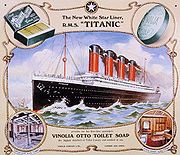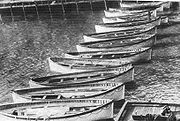
Changes in safety practices following the RMS Titanic disaster
Encyclopedia

Lifeboats

Davit
A davit is a structure, usually made of steel, which is used to lower things over an edge of a long drop off such as lowering a maintenance trapeze down a building or launching a lifeboat over the side of a ship....
which could give the ship the potential to carry 48 lifeboats; this would have provided enough seats for everyone on board. However, the White Star Line decreed that only 20 lifeboats would be carried, which could accommodate only 52% of the people aboard. At the time, the Board of Trade
Board of Trade
The Board of Trade is a committee of the Privy Council of the United Kingdom, originating as a committee of inquiry in the 17th century and evolving gradually into a government department with a diverse range of functions...
's regulations stated that British vessels over 10,000 tons must carry 16 lifeboats with a capacity of 5500 cubic feet (155.7 m³), plus enough capacity in rafts and floats for 75% (or 50% in case of a vessel with watertight bulkheads) of that in the lifeboats. Therefore, the White Star Line actually provided more lifeboat accommodation than was legally required. The regulations made no extra provision for larger ships because they had not been changed since 1894, when the largest passenger ship under consideration was only 13,000 tons, and because of the expected difficulty in getting away a greater number than 16 boats in any emergency.
On the night of the sinking, Titanic's lifeboat complement was made up of three types of boats. The most numerous were the 14 standard wooden lifeboats, each 30 ft (9.1 m) long by 9 inch wide, with a capacity of 65 persons each. Forward of them, one on each side of the ship, two smaller emergency boats, 25 ft (7.6 m) long, had a capacity of 40 persons each. Four Englehardt collapsible lifeboats measuring 27 inch long by 8 ft (2.4 m) wide had a capacity of 47 persons each; they had canvas sides, and could be stowed almost flat, taking up a comparatively small amount of deck space. Two were stowed port and starboard on the roof of the officers' quarters, at the foot of the first funnel, while the other two were stowed port and starboard alongside the emergency cutters.
After the Titanic disaster, recommendations were made by both the British and American Boards of Inquiry stating, in part, that ships would carry enough lifeboats for those aboard, mandated lifeboat drills would be implemented, lifeboat inspections would be conducted, etc. Many of these recommendations were incorporated into the International Convention for the Safety of Life at Sea passed in 1914.
24 hour radio watch and distress rockets
Following the inquires, United States government passed the Radio Act of 1912Radio Act of 1912
The Radio Act of 1912 is a United States federal law that mandated that all radio stations in the US be licensed by the federal government, as well as mandating that seagoing vessels continuously monitor distress frequencies....
. This act, along with the International Convention for the Safety of Life at Sea, stated that radio communications on passenger ships would be operated 24 hours along with a secondary power supply, so as not to miss distress calls. Also, the Radio Act of 1912 required ships to maintain contact with vessels in their vicinity as well as coastal onshore radio stations.
In addition, it was agreed in the International Convention for the Safety of Life at Sea that the firing of red rockets from a ship must be interpreted as a distress signal. This decision was based on the fact that the rockets launched from the Titanic prior to sinking were interpereted with a bit of ambiguity by the freighter S.S. Californian. Officers on the Californian had seen rockets fired from an unknown liner from their decks, yet surmised that they could possibly be "company" or identification signals, used to signal to other ships. At the time of the sinking, aside from distress situations, it was commonplace for ships without wireless radio to use a combination of rockets and Roman candles to identify themeselves to other liners. Once the Radio Act of 1912 was passed it was agreed that rockets at sea would be interpreted as distress signals only, thus removing any possible misinterpretation from other ships.
International Ice Patrol
After the Titanic disaster, the U.S. Navy assigned the Scout Cruisers Chester and USS Birmingham (CL-2)USS Birmingham (CL-2)
USS Birmingham , named for the city of Birmingham, Alabama, was a laid down by the Fore River Shipbuilding Company at Quincy, Massachusetts on 14 August 1905; launched on 29 May 1907; sponsored by Mrs L...
to patrol the Grand Banks for the remainder of 1912. In 1913, the United States Navy
United States Navy
The United States Navy is the naval warfare service branch of the United States Armed Forces and one of the seven uniformed services of the United States. The U.S. Navy is the largest in the world; its battle fleet tonnage is greater than that of the next 13 largest navies combined. The U.S...
could not spare ships for this purpose, so the Revenue Cutter Service (forerunner of the United States Coast Guard
United States Coast Guard
The United States Coast Guard is a branch of the United States Armed Forces and one of the seven U.S. uniformed services. The Coast Guard is a maritime, military, multi-mission service unique among the military branches for having a maritime law enforcement mission and a federal regulatory agency...
) assumed responsibility, assigning the Cutters Seneca and Miami to conduct the patrol.
The Titanic disaster led to the convening of the first International Convention for the Safety of Life at Sea
International Convention for the Safety of Life at Sea
The International Convention for the Safety of Life at Sea is an international maritime safety treaty. The SOLAS Convention in its successive forms is generally regarded as the most important of all international treaties concerning the safety of merchant ships.- History :The first version of the...
(SOLAS) in London
London
London is the capital city of :England and the :United Kingdom, the largest metropolitan area in the United Kingdom, and the largest urban zone in the European Union by most measures. Located on the River Thames, London has been a major settlement for two millennia, its history going back to its...
, on 12 November 1913. On 30 January 1914, a treaty was signed by the conference that resulted in the formation and international funding of the International Ice Patrol
International Ice Patrol
The International Ice Patrol is an organization with the purpose of monitoring the presence of icebergs in the Atlantic and Arctic Oceans and reporting their movements for safety purposes. It is operated by United States Coast Guard but is funded by the 13 nations interested in trans-Atlantic...
, an agency of the United States Coast Guard that to the present day monitors and reports on the location of North Atlantic Ocean
Atlantic Ocean
The Atlantic Ocean is the second-largest of the world's oceanic divisions. With a total area of about , it covers approximately 20% of the Earth's surface and about 26% of its water surface area...
icebergs that could pose a threat to transatlantic sea traffic.
Since the mid 1940s, ice patrol aircraft became the primary ice reconnaissance method with surface patrols phased out except during unusually heavy ice years or extended periods of reduced visibility. Use of the oceanographic vessel continued until 1982, when the Coast Guard's sole remaining oceanographic ship, USCGC Evergreen, was converted to a medium endurance cutter. The aircraft has distinct advantages for ice reconnaissance, providing much greater coverage in a shorter period of time.
Ship design changes
Following the Titanic disaster, ships were refitted for increased safety. For example, the double bottoms of many existing ships, including the RMS OlympicRMS Olympic
RMS Olympic was the lead ship of the Olympic-class ocean liners built for the White Star Line, which also included Titanic and Britannic...
, were extended up the sides of their hulls, above their waterlines, to give them double hulls. Another refit that many ships underwent were changes to the height of the bulkheads
Bulkhead (partition)
A bulkhead is an upright wall within the hull of a ship or within the fuselage of an airplane. Other kinds of partition elements within a ship are decks and deckheads.-Etymology:...
. The bulkheads on Titanic extended 10 feet (3 m) above the waterline
Waterline
The term "waterline" generally refers to the line where the hull of a ship meets the water surface. It is also the name of a special marking, also known as the national Load Line or Plimsoll Line, to be positioned amidships, that indicates the draft of the ship and the legal limit to which a ship...
. After the Titanic sank, the bulkheads on other ships were extended higher to make the compartments fully watertight.

